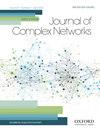Preferential attachment with reciprocity: properties and estimation
IF 1.5
4区 数学
Q2 MATHEMATICS, INTERDISCIPLINARY APPLICATIONS
引用次数: 5
Abstract
Reciprocity in social networks is a measure of information exchange between two individuals, and indicates interaction patterns between pairs of users. A recent study finds that the reciprocity coefficient of a classical directed preferential attachment (PA) model does not match empirical evidence. Towards remedying this deficiency, we extend the classical three-scenario directed PA model by adding a parameter that controls the probability of creating a reciprocal edge. This proposed model also allows edge creation between two existing nodes, making it a realistic candidate for fitting to datasets. We provide and compare two estimation procedures for fitting the new reciprocity model and demonstrate the methods on simulated and real datasets. One estimation method requires careful analysis of the heavy tail properties of the model. The fitted models provide a good match with the empirical tail distributions of both in- and out-degrees but other mismatched diagnostics suggest that further generalization of the model is warranted.具有互易性的优先依恋:性质和估计
社交网络中的互惠性是衡量两个人之间信息交换的一种方式,它表明了用户对之间的交互模式。最近的一项研究发现,经典的定向优先依恋(PA)模型的互易系数与经验证据不匹配。为了弥补这一缺陷,我们通过添加一个控制创建互反边概率的参数来扩展经典的三场景定向PA模型。该模型还允许在两个现有节点之间创建边缘,使其成为拟合数据集的现实候选。我们提供并比较了拟合新互易模型的两种估计方法,并在模拟数据集和实际数据集上进行了验证。一种估计方法需要仔细分析模型的重尾特性。拟合的模型与内外度的经验尾分布都有很好的匹配,但其他不匹配的诊断表明,模型的进一步推广是有必要的。
本文章由计算机程序翻译,如有差异,请以英文原文为准。
求助全文
约1分钟内获得全文
求助全文
来源期刊

Journal of complex networks
MATHEMATICS, INTERDISCIPLINARY APPLICATIONS-
CiteScore
4.20
自引率
9.50%
发文量
40
期刊介绍:
Journal of Complex Networks publishes original articles and reviews with a significant contribution to the analysis and understanding of complex networks and its applications in diverse fields. Complex networks are loosely defined as networks with nontrivial topology and dynamics, which appear as the skeletons of complex systems in the real-world. The journal covers everything from the basic mathematical, physical and computational principles needed for studying complex networks to their applications leading to predictive models in molecular, biological, ecological, informational, engineering, social, technological and other systems. It includes, but is not limited to, the following topics: - Mathematical and numerical analysis of networks - Network theory and computer sciences - Structural analysis of networks - Dynamics on networks - Physical models on networks - Networks and epidemiology - Social, socio-economic and political networks - Ecological networks - Technological and infrastructural networks - Brain and tissue networks - Biological and molecular networks - Spatial networks - Techno-social networks i.e. online social networks, social networking sites, social media - Other applications of networks - Evolving networks - Multilayer networks - Game theory on networks - Biomedicine related networks - Animal social networks - Climate networks - Cognitive, language and informational network
 求助内容:
求助内容: 应助结果提醒方式:
应助结果提醒方式:


